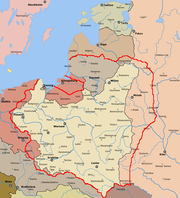- Dmowski's Line
-
Dmowski's Line (Polish: Linia Dmowskiego) was a proposed border of Poland after World War I. It was proposed by the Polish delegation at the Paris Peace Conference of 1919 and it was named after Roman Dmowski, Polish foreign minister. Poland wanted to get Upper Silesia, Pomerelia with Danzig, Warmia and Masuria, all Lithuania, Zhytomyr region and eastern: Belarus, Polesia, Volhynia, Podolia.
Contents
Boundary Line
Boundary line to the east was Polish by the notes from the Polish Delegation as follows:[1]
“ "(...) ranging from the Baltic coast east of Łabiawy boundary line follows the coast to the north of Klaipėda and Palanga. (...) From the coast to the north of Libawa proceed to the east boundary line of the historic border between the Poland 1772, and Courland. It comes in this way to the Iłłukszta county in Courland. This county is recovered by Poland due to its geographical position and the advantage of the Polish element in the population. From here, border proceeds along the limit of Iłłukszta county to Daugava river and passes on its right bank (Vitebsk Governorate) in order to proceed eastward parallel to the river, and approximately 30 kilometers to the borders of the Dryświaty county, including same, along with the Polock county. Next it passes the north-west from Horodka, returns to the left bank of the Daugava River about 30 miles west of Vitebsk and goes toward the south, passing west of the Sienna to the point where it meets the boundary between Minsk and Mohylow Gouvernement, proceeding from the boundary line towards the south until the Berezina in place where it touches the northern border of the Rzeczyca county, then crossing the Berezina, goes in a southwesterly direction to the marshes to the east of Mazyr. From there, crossing Pripyat, the boundary follows the dividing line between the Rzeczyca and Mazyr counties, then, is still proceeding in a south west, passes to the west to the cities of Zwiahel and Ovruch in Volhynia and arrives at the point where the borders of Zaslaw, Ostrog and Zwiahel counties meet. Then, heading south, the frontier line is progressing along the eastern border of Zaslaw and Starokonstantynów counties, to the point where it meets boundaries of Latyczów and Ploskirów counties in Podolia, there is still in a southerly direction until it reaches the river Uszyca near Zińków and goes along its course to the Dniester, which is at this point the southern border between Poland and Romania. " ” This proposal was rejected, and later withdrawn by the author - Roman Dmowski, who during the negotiations ending the Polish-Bolshevik war, spoke out against the inclusion of Minsk. He explained the desire to build a country without ethnicl minorities - the de facto theme was the desire to prevent the concept of federation (Międzymorze) of Jozef Pilsudski, even to a limited extent. Consequently, the Treaty of Riga the Polish-Soviet border demarcated in the distance about 30 km to the west and north of Minsk. Polish territory according to the concept Dmowski was supposed to be equal to 447 000 km ² .[2]
See also
References
External links
Categories:- Second Polish Republic
- Foreign relations of Poland
- Polish history stubs
Wikimedia Foundation. 2010.

